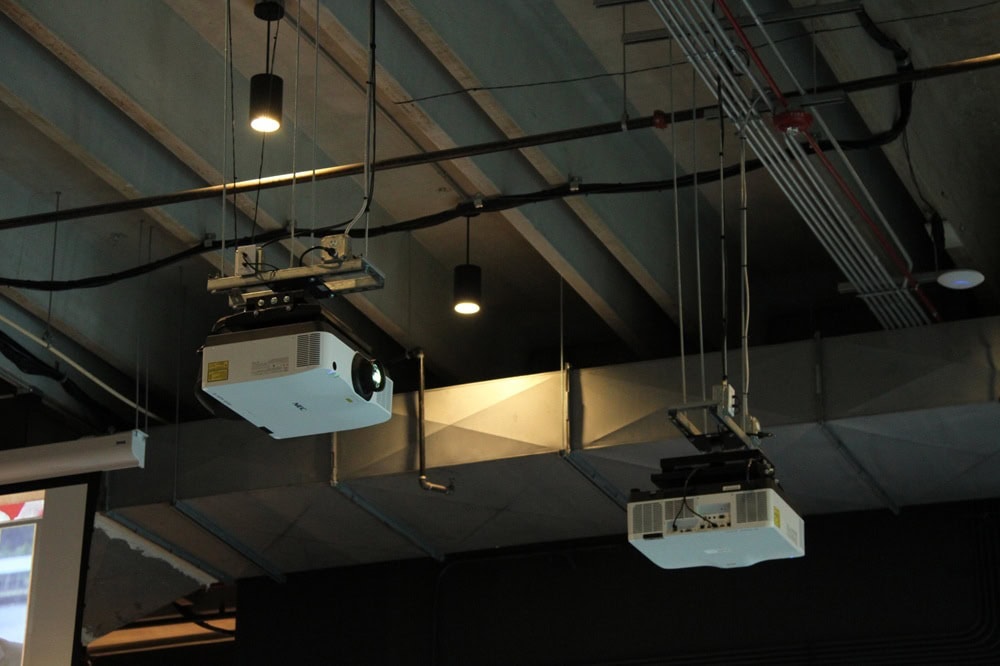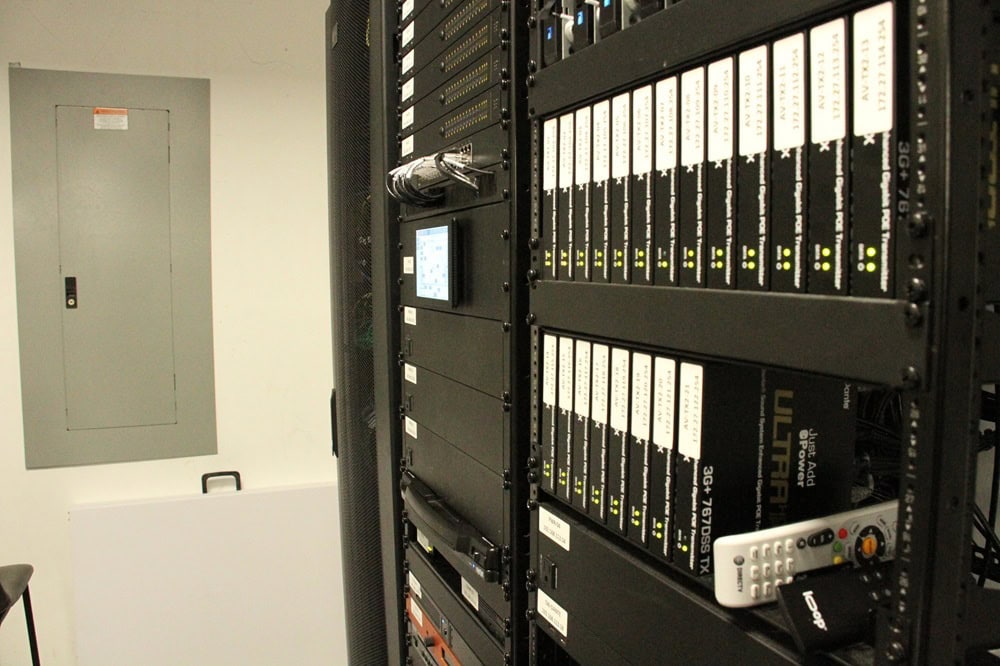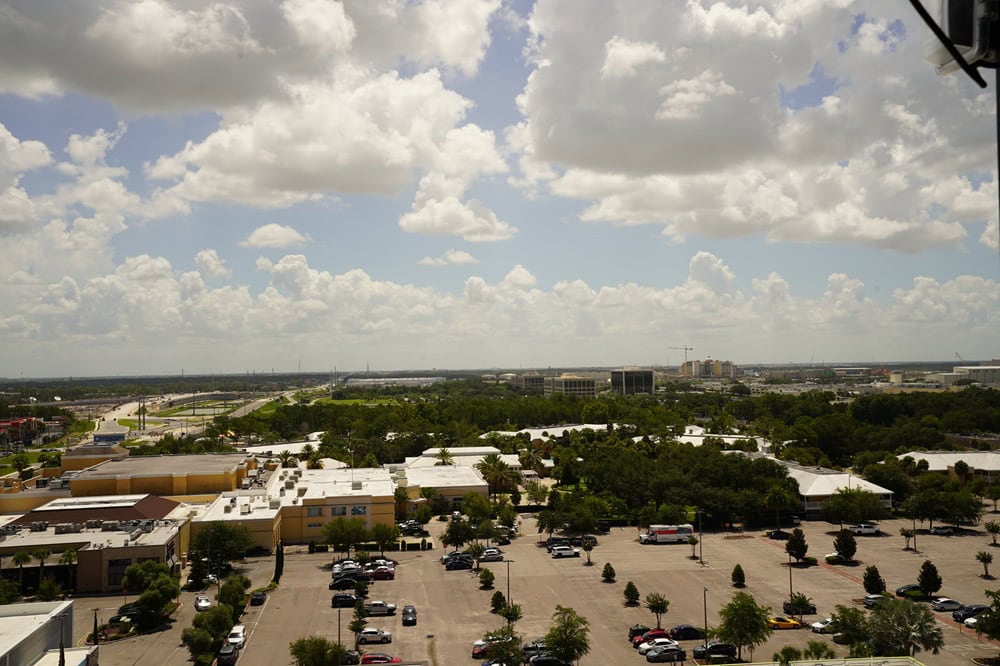You’re halfway through your restaurant build. The place looks incredible. Then the speakers turn on… and it sounds like someone’s playing music through a soup can.
This happens more often than you think. Beautiful spaces end up with underperforming sound systems because the AV was treated like another box to check instead of a core part of the guest experience.
Here’s why leaving AV decisions to your design team, without bringing in a licensed integrator, can quietly wreck your atmosphere, your operations and your bottom line.
The Hidden Problem in Commercial Constructions
There’s a silent gap in most new builds: AV planning.
Architects are, hands down, brilliant at designing spaces that look great, function well and pass code. But when it comes to technology, especially audio and video solutions, they’re often expected to spec systems outside their wheelhouse. That’s not on them. It’s baked into how most construction projects are structured.
Here’s how it typically goes: the design team includes speakers, displays and other AV elements early in the plans, mostly for aesthetics and layout. But those choices are rarely based on acoustic modeling, real-world usage or integration needs.
The result? AV systems that tick the design box but fail the performance test the moment you power them on.

Why It Keeps Happening and WhY NO ONE’s to Blame
We’re not throwing architects under the bus. The problem is systemic.
Architects are expected to deliver complete build specs, including lighting, plumbing and technology. So when AV comes up, they tend to treat it like everything else: pick hardware that fits the look, place it where it doesn’t disrupt the design and move on.
The issue is, AV doesn’t work that way.
Architects Prioritize Design
When architects look at AV systems, they’re often zeroing in on aesthetics and how the technology integrates with the space visually:
- Will the speakers blend into the ceiling?
- Can we mount the TV without ruining the sightlines?
- What’s the cleanest visual layout?
AV Pros Prioritize Performance
AV integrators, on the other hand, think in terms of functionality, sound behavior and long-term flexibility:
- How will sound behave once the room is full?
- Is there enough processing power for multiple zones?
- Can this system adapt during peak hours or live events?
You need both perspectives. Aesthetic decisions shouldn’t override technical ones. Otherwise, you get good-looking gear that doesn’t sound (or function) the way they should be.
The Real Cost of Getting AV Wrong
According to a Zagat survey of 13,000 diners, noise topped the list of restaurant complaints and has been deemed “the most bothersome,” outranking even bad service and overcrowding. It’s a clear sign that poor acoustics aren’t a minor annoyance but deal-breakers for many customers.
In a Harvard Business School study, it showed that a one-star increase in Yelp rating can lead to a 5–9% revenue boost. Many of those ratings come down to perceived atmosphere, sound, and overall experience. Poor AV drags all of that down.
It’s easy to overlook the audiovisual side during the design phase. But done poorly, the fallout ripples across your operations and your bottom line.

Immediate Impact
A bad sound system changes how people feel in your space. Customers struggle to hold a conversation. Staff can’t hear each other over the noise. The vibe you worked so hard to design gets flattened.
People don’t linger, they don’t come back and they definitely don’t tell their friends to check out your place. For your team, communication breakdowns add stress and inefficiency to every shift. It’s friction you never budgeted for.
Long-Term Consequences
Over time, the cost multiplies. Fixing AV after the walls are up is expensive, messy and frustrating. You’re no longer simply swapping equipment. You’re re-running conduit, patching drywall and working around operating hours.
Meanwhile, poor acoustics continue to chip away at customer retention and staff productivity. These become baked into your revenue losses and operational headaches.
A Cautionary Tale
We’ve seen this story play out far too often. One high-end sports bar came to us after two failed attempts to fix their audio. The original system, specified during construction, was visually sleek, but completely unfit for the acoustics of a bustling restaurant.
By the time we were brought in, they’d already spent $35,000 chasing a solution. What they really needed was a fresh system design that should’ve cost $15,000 from the start. Total outlay by the end? Over $80,000.
When AV Actually Matters (Spoiler: It’s Almost Always)
Every space has a distinct acoustic signature, a different use case and a different set of expectations. And in nearly every commercial setting, the audiovisual system directly shapes the customer experience and the team’s ability to perform.

Restaurants and Bars
A quiet dining area and a rowdy bar shouldn’t sound the same. You need separate zones with their own volume controls. The acoustics of a concrete-heavy space demand different treatment than a booth-filled lounge. From paging systems to playlist transitions, the AV has to work with and not against your flow.
Hotels and Hospitality
Hotel AV has to walk a fine line. That is, it needs to disappear into the background while performing across diverse environments. Lobbies, lounges, ballrooms and guest rooms each have their own demands. Consistent ambiance, clean sound and seamless control help you deliver a polished guest experience at every turn.
Retail Environments
Sound shapes behavior. In retail, the right background music can encourage browsing and influence purchase decisions. Displays, digital signage and soundscapes should all be connected and easy to manage. If your system can’t adapt to seasonal changes or store zones, you’re leaving opportunities on the table.
Sports Bars and Entertainment Venues
Crowds want clarity, especially when multiple games are playing at once. Your audio/video system should direct attention, hold up under pressure and adapt on the fly. Precision matters, whether that’s highlighting a big play or switching focus from trivia night to a UFC fight.
Corporate Spaces
Boardrooms, huddle spaces and open offices all need different AV solutions. Poor sound in a video conference leaves the wrong impression. Outdated equipment slows down meetings. Sound masking and control interfaces are an integral part of your team’s workflow.
The Design-Build Revolution: Getting Everyone on the Same Team
The smartest projects today are built by a team that knows when to step forward and when to let the specialists lead. AV doesn’t belong in a vacuum. It belongs in the design conversation from the very beginning, right alongside architecture, lighting and mechanical systems.
How True Collaboration Works
In a well-executed design-build process, AV professionals aren’t brought in after the drywall goes up. They’re in the room during planning, guiding decisions on infrastructure, equipment access and system integration.
Designing with Dual Perspectives
When an architect sketches ceiling lines or lighting concepts, the AV team is already thinking about speaker placement, cable paths and control systems that will actually work once the space is filled with people.
Balance Between Aesthetics and Performance
During design, architects make certain the space feels right while AV experts ensure it sounds right and works under real-world pressure. Both disciplines influence each other and when they’re aligned, the final result performs on opening day.
Smoother Installs, Better Outcomes
Installation is where the blueprint becomes reality. If the AV team has been part of the process from day 1, installation is smoother, faster and far less prone to compromise. No last-minute reroutes or awkward retrofits. Only a cohesive system that blends form and function.
The Benefits of Getting It Right
When architects and AV professionals collaborate from the outset, the payoff shows in every detail. You get a space that sounds good and a system that supports your business goals from the very start.
Aesthetic Integration
When AV is part of the design process, it doesn’t have to be hidden or camouflaged poorly. Speakers, displays and control panels can be built into the architectural vision instead of tacked on afterward. The outcome is a space that doesn’t feel improvised.
Functional Optimization
AV professionals design not just with appearances in mind but use. That means systems are built to handle your busiest nights, your quietest afternoons and everything in between. Volume levels, audio zoning and control interfaces are all chosen to work under pressure.
Cost Efficiency
Retrofitting is expensive. When audio and video are designed and installed correctly from the start, you avoid the cascade of fixes, workarounds and upgrades that come with cutting corners early on. You invest once and that investment works.
Future Flexibility
Spaces change. Menus change. Crowd patterns shift. A well-planned AV system includes infrastructure that can evolve with your business, whether that is expanding to more zones, integrating new tech or scaling up for events.
Performance Reliability
When AV solutions are designed with real-world usage in mind, they work. You don’t need to reboot speakers, troubleshoot microphones or train staff for hours. The systems support your team quietly in the background, day after day.
Questions to Ask Before Your Architect Specs Technology
Before anyone drafts a single AV line item into your project specs, it’s worth asking the questions that separate surface-level recommendations from real, functional design. These conversations reveal whether your build team understands AV performance or if you’re heading toward expensive corrections down the road.

Technical Experience
Start with the basics: Has your architect or specifier worked on commercial AV systems before? Not just residential or office-level tech but full-scale restaurant, retail or hospitality systems. If they can’t reference recent, relevant projects, you may be relying on guesswork rather than demonstrable expertise.
Performance Understanding
Ask how the system will handle your peak hours (when the dining room is full, the bar is buzzing and ambient noise is at its loudest). A true AV designer will talk in terms of sound pressure levels, acoustic challenges and real-time control, not just brand names or speaker counts.
Integration and Flexibility
Good AV systems don’t operate in isolation. They connect with your lighting, paging, point-of-sale and sometimes even HVAC. Your spec should account for these integrations, as well as your ability to grow or shift how the system behaves over time.
Support and Maintenance
Once the project wraps, who’s accountable for support? Will your staff know how to adjust zones, update the system or troubleshoot if something malfunctions? If the answer is “it’s intuitive,” that’s not good enough. You want clarity around support, warranty and ongoing training from day 1.
Case Study: When Collaboration Gets It Right
A recent project we accomplished shows what’s possible when AV becomes an integral part of the design conversation.
The developer was planning a 12,000-square-foot mixed-use venue: part restaurant, part sports bar, with private event spaces folded in. From the very first schematic, our AV team sat at the table with architects, interior designers and contractors. It’s an early integration that allowed the entire space to be designed around a shared vision.
The challenge
The challenge was complexity: each zone needed to function independently with its own mood, sound levels and sources. But for larger events, the space also had to come together as one unified experience. Case in point: distributed audio, zone control and seamless transitions, without clashing with the modern aesthetic the architect envisioned.
The solution
The collaboration was a success because everyone stayed in their lane. The architect designed acoustic ceiling features that blended with the lighting and sound treatments. We built out a zone-based AV backbone that remained invisible to guests but easy for staff to control. Lighting was mapped alongside audio, so scene changes could be coordinated.
The result
Come opening day, the AV system performed exactly as pictured – no technical issues, zero customer complaints. Also, staff could easily manage the space, effortlessly adjusting audio and video zones to fit different crowds and dayparts.
That ease of operation helped create a seamless experience, with the venue reporting a 23% higher average spend per guest in comparison to similar businesses in the area. Even more impressive? The entire project came in at 12% less than what a typical retrofit of this scale would cost.
Red Flags: When Your Project Might Be Heading for Trouble
You can usually spot a misaligned AV plan long before the sound check flops. Problems start to surface quietly on paper, in planning meetings or during the first round of installation. If you know what to watch for, you’ll save yourself tens of thousands and months of backtracking.

Vague AV Specs in Early Planning
In the early planning phase, one of the biggest giveaways is a vague AV spec buried in a spreadsheet. If your AV plan shows up as a single line item, e.g., “sound system” with no breakdown of zones, control logic or equipment, it’s a sign no one’s really thinking through how the space will function.
Similarly, if there’s no acoustic modeling or analysis in the design set, you’re not planning for how sound will behave in real life, only how it looks on paper.
AV Infrastructure Delays During Construction
During construction, delays around AV rough-in or infrastructure installation usually mean the system wasn’t fully coordinated. We’ve seen projects where conduit paths weren’t mapped, speaker locations conflicted with ductwork or electrical needs were underestimated.
These are signals that AV wasn’t in the loop during layout coordination and you’ll likely pay for it with change orders later.
Operational Confusion Before Opening
Then there’s the pre-opening panic. If you’re approaching soft launch and someone still hasn’t explained how to actually operate the system, or worse, you’re hearing things like “it’s pretty self-explanatory,” you’re in trouble.
At this stage, every tech system should be tested, every staff member trained and every function mapped to a real operational scenario. If integration with lighting, POS or paging feels clunky or incomplete, that’s another late-stage warning sign.
In short: if your AV is treated as a checkbox rather than a central part of the guest experience, the cracks will show, often right when you can’t afford for anything to go wrong.
The Path Forward: Making Better AV Decisions
In 2021, more than half the companies that invested in customer service technology, including AV systems, reported exponential growth and productivity gains. It only goes to show that proper AV design is an operational upgrade that pays off.
So if you’re in the planning stages of a new space, or even reworking an existing one, there’s still time to get your AV correctly. But it takes a shift in mindset: one that treats sound, visuals and control systems as critical parts of the customer experience.
Bring AV Specialists in Early
The biggest mistake we see is bringing in AV too late. By the time construction drawings are finalized, most infrastructure decisions are locked. Ductwork, conduit paths, ceiling grids, they’re already in place.
At that point, AV is forced to conform to decisions it should have helped shape. Looping in AV specialists during schematic design makes a tremendous difference. We can help plan infrastructure, anticipate integration needs and work directly with architects.
Design for Real-World Use
You’re not building a restaurant for opening night. You’re building it for a packed Friday happy hour, a loud Saturday dinner rush and a quiet midweek lunch crowd. Your AV system should adapt to all of those. If the plan only accounts for aesthetics or average use, you’re setting yourself up for long-term frustrations.
Budget for Infrastructure
Cabling, conduit, control processors and acoustic treatment rarely get the spotlight, but they’re what make systems reliable. Cheap out here and it doesn’t matter what brand of speakers you install. They won’t sound good and they won’t last. Plan for the backbone, not just the surface.
Prioritize Control and Flexibility
The best systems are the ones your staff can actually use. If your AV gear requires a manual and a prayer to operate, it’s not well-designed. Good control interfaces, intuitive presets and automation features make it easy for managers and hosts to run the room confidently without calling tech support.
Future-Proof the Foundation
The system you install today will evolve and your business will too. Build a foundation that’s ready to grow. Think extra conduit paths, scalable processors, network-based audio. That way, when your space expands or you need a new feature, you’re not starting from scratch.
Don’t Let Great Design Fall Flat
There’s no shortage of moving parts in a commercial build. But sound shouldn’t be the weak link that pulls the entire experience down.
Architects bring the vision. Designers shape the space. But without the right AV expertise baked in from the start, even the most beautiful build can fall flat when it comes to how it actually feels and functions for your guests.
At Crunchy Tech, we’ve spent years fixing systems that never should’ve been broken in the first place.
Planning a new project? Loop us in early. It’s the easiest way to protect your experience and your investment.
